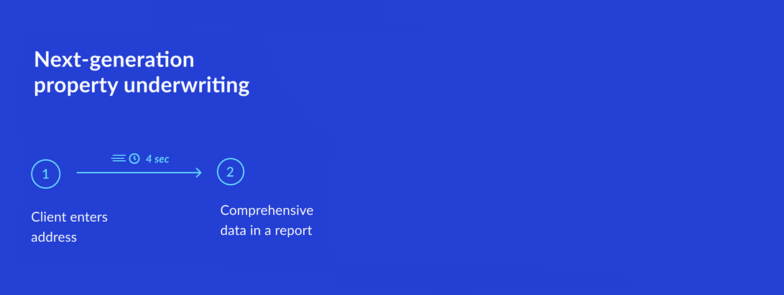Introduction
As technology keeps getting better, businesses in all fields are finding new ways to run more quickly and accurately. Property and casualty (P&C) insurance is no different, as the industry struggles to make the best use of the huge amounts of big data analytics it has access to. The use of artificial intelligence (“AI”) in the underwriting process is one of the most important changes. The use of what we’ll call “Property Intelligence” is changing the way that replacement costs are calculated. This gives underwriters a level of rigor and insight that was previously impossible.

The Challenge to Underwriters of Property Insurance
The underwriting of property typically relies upon a process that has been in place for decades, and which requires manual input of data. This labor-intensive approach to quoting submissions creates a substantial margin for error in risk quantification. Apart from faulty input by the user, commercial property values are usually adjusted based on inflation. On average, roughly 80% of a Property Insurance underwriter’s book of business will be renewed annually. Most of these renewals will rely upon the Schedule of Values submitted by the broker. Data provided by insureds and their brokers tend to be questionable since neither party is incentivized to update this information to disclose material changes in the risk. The result is that underwriters are sometimes left to provide quotes without sufficient time to independently verify the values that have been furnished by the broker. Each renewal cycle that fails to account for other factors impacting a building’s condition only compounds the level of inaccuracy. It also makes scalability elusive, since there is little, if any, automation built into the workflow.
This is where the Property Intelligence platform can help. By drawing upon the vast reservoirs of data now available through advancements in technology, property Intelligence can bring valuable insights about greater efficiency in quotations, more accurate pricing, and reduced labor costs to insurers. It even enhances customer relationship management and user experience by improving turnaround times and calling attention to conditions that the insured can address to reduce the likelihood or severity of a future loss. The broker benefits as well, by having the information needed to justify rate increases to the insured and being able to deliver actionable intelligence about remedial measures that can be taken to improve the insured’s risk profile.
What is Property Intelligence?

Property Intelligence is when AI and machine learning are used to predict the possible risks of insuring a property.
Different kinds of information about a property are collected and fed into algorithms that help with pricing decisions. Property insurance underwriters need better information. This is clear to anyone who knows about the business. In the past, it has been hard for the underwriting process to take into account damage that was already there, which can lead to adjusters paying for repairs that were not caused by the event that led to the claim. Better underwriting is better-informed decisions that can be made with more solid data. The Property Intelligence platform helps underwriters find portfolios that may not be doing as well as they should so that the prices can be changed or the policy can be canceled. Insurance companies can also better manage risk and their loss ratios if they know more about the state of a property before a claim is made.
Why Not Send an Inspector?
There are times when inspections need to be done in person, but generally speaking, it’s not practical to rely on the property owners for inspections for a whole book of business. For a residential property, sending an inspector can cost hundreds of dollars, and for a commercial property, it can cost up to a couple of thousand dollars. It can take days or weeks longer to finish the underwriting process because of the inspector’s schedule and the time it takes to get to the subject property. So, underwriting decisions are often based on information from the insured or their brokers that hasn’t been checked. Because there isn’t enough reliable data, underwriters want a more streamlined way to figure out and quickly assess how risky a property is when it comes to its value. In-person inspections take half as long and cost half as much as they did before Tensorflight.
Key Components of Property Intelligence
Tensorflight’s AI model employs a three-step process to bolster the rationale for underwriting decisions.
First, we draw upon traditional data points, such as square footage, construction type, façade material, and year built, along with 3-D modeling and cubature. We also consider advanced attributes like building embedding vectors, which are quantified using Computer Vision and AI algorithms. These factors are not unlike those employed by underwriters using conventional methods; the difference is that underwriters ordinarily rely upon human input for this information, whereas our process is automated and reduces the margin for error.
Next, our model uses machine learning and AI to predict replacement costs. Our recent, up-to-date satellite and aerial imagery, ground-level photography (where available), and even tax records are fed into the algorithm to provide data-driven output. This step is largely absent from traditional underwriting methods.
Finally, our results are validated by comparison with standard industry cost databases. What constitutes the final checkpoint in our model is the primary (and in some cases exclusive) basis for replacement cost calculations by underwriters operating without the benefit of AI.
Benefits of Property Intelligence Data to the Underwriter
Tensorflight’s model delivers clarity to underwriters and helps them prioritize their review of risks. The replacement costs are accompanied by a “confidence score” which enables the underwriter to determine the likelihood that the automated results derived from the Tensorflight model are consistent with the automated valuation models of the risks that the underwriter is seeking to cover. Based on the given confidence score and maintenance costs, Tensor Flight can help the underwriter identify:
- Which properties are straightforward enough for the underwriter to “auto-bind” insurance coverage; This will comprise the majority of properties that we review;
- Which addresses should be further reviewed by our team of professionals – depending upon the nature of the market, this could make up anywhere from 5-30% of the properties in question; and
- Which buildings warrant an in-person inspection – no more than 10% of the subject properties should fall in this category, and in some markets, this figure may be as little as one percent.
Impact on the Insurance Industry

You can’t say enough good things about how valuable Property Intelligence is to insurance. The best Property Intelligence software can make the underwriting process faster, more accurate, and more efficient by using AI and machine learning algorithms. In fact, Tensorflight’s model has been able to match and even beat what human experts can do when it comes to classifying property type, risk, and other important tasks. This lets insurers figure out which property attributes and risks are most likely to lead to losses in the future. Fewer claims and better loss ratios are the results of more accurate valuations.
Property Intelligence also offers ease of use. Underwriters can just type or copy and paste the address of the property into the search bar, and Tensorflight will give them information about the building and the property in seconds. Underwriters have access to new images, data reports from outside sources, and advanced visualizations that show things like defensible space and measurement views. With this information, underwriters can make quotes in a fraction of the time it takes to do it the old way. When insureds can get instant quotes and find out how much property intelligence software costs, they can compare prices and are more likely to choose to sign with your company, even if the premiums are higher than what another insurer might have offered.
Property Intelligence also lets insurance companies grow their business without hiring a lot more people. Automation of the underwriting process speeds up decision-making by getting more informed decisions and rid of the most time-consuming part of the process, which is the need for a lot of human input. Underwriters who want to get quotes for more than one property can upload a Schedule of Values (SoV) through our web portal or by sending it to us by email. Tensorflight will improve the dataset and send back an updated SoV within 24 hours. We are working to cut this time down to as little as one hour. With these updated values in hand, the underwriters can then look at the individual properties’ locations, flood patterns, environmental risks, and other factors to decide how much they are worth. Tensorflight is sure that no risk is inherently “good” or “bad,” but that risks can be priced wrong, sometimes in a big way. Property Intelligence wants to help people find a systematic way to solve this problem.
Addressing Anomalies
Even though the best Property Intelligence software makes things easier, there is no perfect analytics tool. In some situations, the algorithm might come up with a value that doesn’t match what a person can see is true about a subject property. Such oddities could be caused by things like strange facades that don’t seem to fit with the property’s intended use or high-rise office buildings with a lot of floors that are hard for Computer Vision technology to count. Geocoding comes with its own problems. A single property can have more than one address, and multiple properties or several buildings from different properties can share the same address.
Tensorflight understands this. When a property’s value seems to be different from what was expected, our own property data analysis team will check the type of occupancy and look at outside data like tax records, business databases, or review sites. With these extra data sources, we can fix many of these issues without having to check them by hand. We can be so specific because we train and test our models on more than 200,000 buildings. Our “confidence scores” are based on how likely it is that we will give the right answer based on that training set of property attributes. The truth is that no method of valuing can be accurate 100% of the time. Even valuations that are based on a property being looked at in person can become out of date when new construction or renovations are done. Tensorflight’s method only involves people when the algorithm’s results need to be checked by a second set of eyes.
What Separates Tensorflight’s Property Intelligence from Other Valuation Methods?

Tensorflight has a world-class team of AI & Computer Vision experts but also other professionals; P&C insurance leaders, underwriting professionals, architects, constructors, and civil engineers. The work of our employees has been featured in leading journals covering advanced computing and artificial intelligence. Some factors which make our Property Intelligence model unique include:
- Adaptability. Traditional methods have been shown to lag changing market conditions. We witnessed this phenomenon during the COVID-19 pandemic, where certain locations in densely populated areas dropped precipitously in fair market value while other, more remote locales became more attractive seemingly overnight. Property Intelligence allows these values to be updated immediately.
- Granularity. Property Intelligence pulls in a greater number of data points, factoring them into each iteration of the model and continually refining the output.
- Confidence Scores. As discussed earlier in this article, Property Intelligence provides guidance around the degree to which a valuation can be relied upon relative to a defined training set consisting of over 200,000 buildings. Traditional methods don’t offer this level of quantification around the potential uncertainties associated with their results.
- Flexibility. The Tensorflight model can be adjusted to aid the underwriter with custom requests or unusual properties, where replacement costs might be difficult to estimate relying solely upon human input.
Other “startups” have begun integrating AI analytics into property underwriting. Some of these depend primarily upon aerial imagery. This may be suitable for the U.S. market, but even there, the underlying data can be scant. American property underwriters typically refer to a database of historic property inspections, yet approximately 50% of buildings aren’t even in this database. And global property underwriters need to access other sources of data in markets where aerial imaging is unavailable. Tensorflight has launched a partnership with Airbus, equipping us with Pleiades Neo Satellite technology. Additionally, we are one of the very few companies that support running servers in the European Union, and as such are compliant with the requirements of the General Data Protection Regulation (GDPR). Furthermore, while we do offer services to residential property underwriters, Tensorflight’s focus is on commercial properties. This is why our use of AI is so important – it allows us to consider the entire structure in calculating replacement cost, rather than only the roof.
How Tensorflight Delivers Efficiency
The commercial property insurance market is literally awash in data that is not being fully leveraged in the underwriting process. Tensorflight utilizes AI to pull in aerial, satellite, and ground-level imagery, along with traditional property intelligence data points like tax records and 3-D modeling. Altogether, our Property Intelligence model is fed by more than 20 data sources, using top property intelligence software and these are identified to the underwriter in delivering the valuation of the subject property. Tensorflight’s model also considers loss data collected from the insurance industry’s experience with Property claims to calculate replacement cost. Additionally, the model is updated quarterly to account for changes in inflation and cost indexes. AI offers consistency and efficiency; it never gets bored or fatigued, and it isn’t prone to making careless errors.
The Future of Property Intelligence

Some trends we are watching in the world of Property Insurance include:
- Frictionless Underwriting. The “Direct to Customer” service model is already happening in the residential space, and we can expect this arrangement to expand to the smaller account segment in the commercial market.
- Enhanced User Experience. Policyholders are looking for more than the annual “stack of paper” from their underwriters. They are demanding web portals, mobile apps, instant access to their coverage specs, and automated quotation and binding. They also want a seamless claims experience. Insurers will need to use AI and machine learning to deliver these features.
- Predictive Analytics. Recent technological advancements will allow underwriters to identify potential problems before they occur, such as leaky roofs and equipment failures. Sharing this information with insureds and their brokers provides an opportunity to take remedial action, thereby avoiding future losses.
- API Connectivity. The use of an Application Programming Interface enables discrete computer applications to “talk” to each other and import data from one application to another. This innovation will bring greater efficiency to claims handling and expedite the adjustment of losses.
Increased Digitization and Automation. The overall efficiencies brought about by automation will reduce costs and improve service delivery to policyholders and intermediaries.
Summary
Property Intelligence represents a quantum leap in the underwriting of commercial property risk. The integration of more robust data with advanced analytics delivers powerful insights and speedier and more accurate valuations. The benefits to the insurance industry are manifold – improved pricing, expedited quotes, and decreased losses. Policyholders and their brokers will come to appreciate the ease of use offered by AI-driven property intelligence platforms and can take proactive measures to address structural deficiencies, thereby preventing losses before they occur.
For a demonstration of our Property Intelligence offering, contact us.

